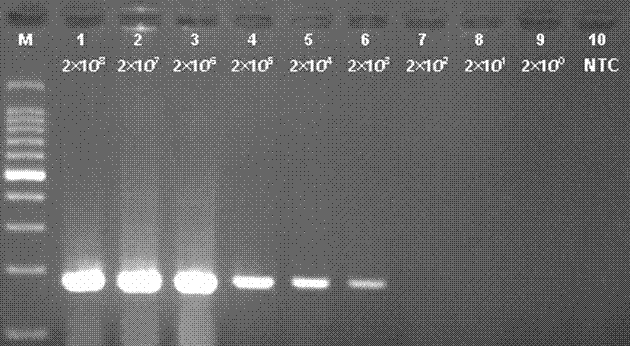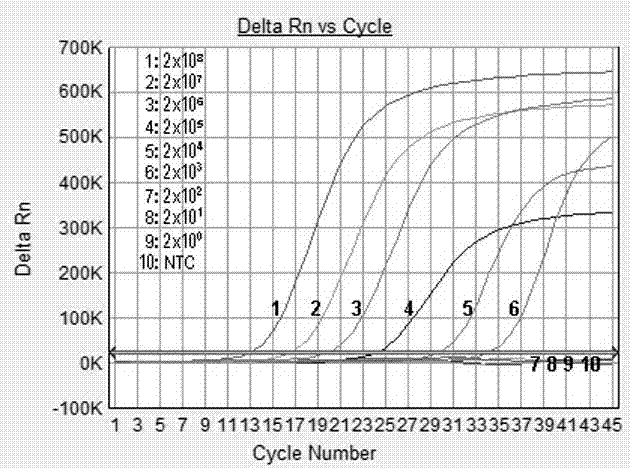Astrovirus real-time isothermal amplification detection kit, its primers and probe
A detection kit and astrovirus technology, applied in the field of rapid detection of enteric pathogens, can solve problems such as difficulty in designing viral nucleic acid molecules, and achieve the effects of improving detection sensitivity, ensuring specificity and strong specificity
- Summary
- Abstract
- Description
- Claims
- Application Information
AI Technical Summary
Problems solved by technology
Method used
Image
Examples
Embodiment 1
[0031] Example 1: Design of real-time NASBA primers and probes
[0032] According to the gene sequence analysis of ORF2 5′ end of astrovirus genome, astroviruses have been divided into 8 serotypes. Molecular epidemiological research data show that the most widespread astrovirus serotype worldwide is type 1. Firstly, 100 whole-genome DNA sequences of human astroviruses were downloaded from the NCBI gene bank in the United States, and then the homology comparison analysis was performed on the downloaded sequences using the molecular biology software DNAMAN 6.0 (Lynnon Corporation, Quebec, Canada) to find highly homologous The conserved sequence of the gene was used as a candidate region for primer and probe design, and the primer and probe design was carried out in combination with the software Oligo 7.56 (Molecular Biology Insights, Inc. USA). The design idea is to comprehensively consider the specificity and generality of the detection of astroviruses (degenerate bases are ...
Embodiment 2
[0042] Example 2: Establishment and optimization of astrovirus real-time NASBA detection system
[0043] The conditions were optimized for some important influencing factors of the real-time NASBA detection system.
[0044] 1. Method
[0045] (1)K + Concentration: prepare 2× real-time NASBA reaction solution according to the reaction system in Table 1, fix other parameters, and adjust K respectively + The final concentration was 40mM, 60mM, 80mM, 100mM, 120mM, 240mM, and real-time NASBA isothermal amplification was performed using in vitro transcribed RNA from a part of the genome fragment of astrovirus as a template. After the experiment, compare different K + Effect of concentration on amplification efficiency and fluorescence curve.
[0046] (2) Concentration combination of dNTP / NTP: Prepare 2× real-time NASBA reaction solution according to the reaction system in Table 1, fix other parameters, and adjust the final concentration of dNTP / NTP to 0.1mM / 1.6mM, 0.2mM / 1.6mM,...
Embodiment 3
[0051] Embodiment 3: Composition and detection method of real-time NASBA kit for detecting astrovirus
[0052] 1. Composition of the kit (stored at -20°C)
[0053] (1) 2× real-time NASBA reaction solution: its components are: 120mM Tris-HCl (pH8.0), 240mM KCl, 20mM MgCl2, 24mM DTT, 4mM spermidine, 0.4mM dNTP, 3.2mM NTP, 0.3mM trehalose, 0.4mM Betaine, 30% DMSO, 0.8μM Forward Primer F1, 0.8μM Reverse Primer R1, 0.4μM Molecular Beacon Probe P1; wherein the forward primer F1 is the nucleus shown in SEQ ID NO:1 Nucleotide sequence, the reverse primer R1 is the nucleotide sequence shown in SEQ ID NO: 2, and the molecular beacon probe P1 is the nucleotide sequence shown in SEQ ID NO: 3;
[0054] (2) 5×enzyme mixture: its components are: 1.5 U / μL AMV reverse transcriptase, 6 U / μL T7 RNA transcriptase, 0.0625 U / μL RNAase H enzyme, 5 U / μL Ribonuclease Inhibitor, 20 mg / mL BSA, 8 mM sorbitol;
[0055] (3) Positive control: a partial genomic RNA fragment transcribed in vitro by Astr...
PUM
 Login to View More
Login to View More Abstract
Description
Claims
Application Information
 Login to View More
Login to View More - R&D
- Intellectual Property
- Life Sciences
- Materials
- Tech Scout
- Unparalleled Data Quality
- Higher Quality Content
- 60% Fewer Hallucinations
Browse by: Latest US Patents, China's latest patents, Technical Efficacy Thesaurus, Application Domain, Technology Topic, Popular Technical Reports.
© 2025 PatSnap. All rights reserved.Legal|Privacy policy|Modern Slavery Act Transparency Statement|Sitemap|About US| Contact US: help@patsnap.com



